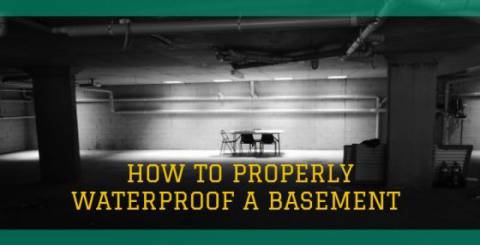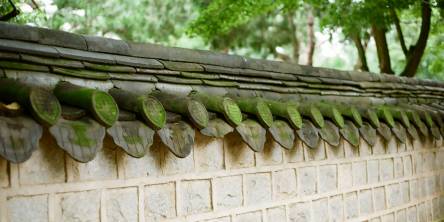How to Properly Waterproof a Basement

Getting your basement waterproofing correct from the beginning is very important. Many bigger problems and damage can be caused if the process is not completed correctly. Whether you’re undertaking wet basement repair or attempting to fix the waterproof foundation of your basement, there are many things you can do to protect your home. The following steps will talk you through the methods of waterproofing your basement so that you don’t encounter any trouble in the future. As always, if you are unsure about any of the techniques mentioned below, you should speak to a professional who will be able to complete the job thoroughly for you.
Finding the Cause of the Moisture
Before you start the basement waterproofing process, you might want to explore where the damp is coming from in the first place. You can do this by taping a piece of foil to your basement walls overnight; this should be around 1-foot square to cover a large enough area. When you return to the foil the next day you might see condensation on the outside, which means the humidity levels are particularly high in your basement. This can be addressed by using a dehumidifier in your basement for the long term. However, if you notice condensation on the inside surface of the foil, this means that you have damp in the surrounding areas of your basement, perhaps from soil outside. In this case, waterproofing your basement is a good step to take.
There are two ways to waterproof your basement; you can treat it from the interior or the exterior. It is proven that an exterior waterproofing treatment is much more effective, although it might cost you slightly more. Here are some types of interior waterproofing that might help you to combat future damp problems in your basement.
Interior Waterproofing Methods
Concrete Waterproof Coatings: This waterproofing method involves using a thick membrane that is much like cement. Once this has dried onto the wall it will stick there permanently and protect from moisture to a certain extent. This coating can be applied by using a heavy brush made of natural fibres. You can also make it look quite attractive upon finishing by using a swirling technique with your chosen brush. Remember that you can’t apply this sort of coating to a wall that has been painted before, so check the label for clear instructions. You tend to buy the mixture as a dry treatment and then you add water as instructed to create the mixture.
Waterproofing Paint: This is quite similar to regular wall paint; however it needs to be applied much more thickly. This is a cheap option that will serve you well to a certain extent, as long as the damp isn’t too severe or coming from the exterior of the home.
Plastic Panels and Sheets: These will prevent water from ruining your basement, but they won’t necessarily prevent moisture completely. The water that does get through the wall will run back down the plastic into an alternative drainage system in the floor. It’s a slightly trickier system, but worth exploring.
Silicate Based Concrete Sealers: This type of waterproofing is also called a densifier and it also only suitable on surfaces that haven’t been previously painted or sealed. This concrete sealer is effective as it soaks into the wall and creates a chemical reaction with the brick; this will then form a protective waterproof barrier. This is a good method as it won’t peel off or fade and they can often be painted over once dry. This is an easy enough DIY project as you can use any equipment such as a roller, brush or sprayer, depending on the size of your space.
The Benefits of Exterior Waterproofing
Although these methods will help to waterproof your basement to some extent, your best bet is certainly exterior waterproofing. It is highly recommended that you seek professional help for this type of work on your home. A full-scale exterior waterproofing treatment for your basement will need an experienced professional, rather than a bit of DIY handiwork. This process will involve excavating all around the outer perimeter of the house right down to the foundations. Then a waterproof coating will be installed along with drainage panels to prevent moisture from entering your basement. The drainage panels allow water to flow by gravity away from the foundation, so your basement is well protected.
So carry out your basement waterproofing today and keep your home safe from unwanted damp and mould. Not only will this keep your family safe, but it will also prevent long term damage to the interior and exterior of your home.
Similar Articles
The exterior of your home is the first thing to deal with the elements and with each season, your home will be challenged in a certain way.
Most pests enter homes through cracks, gaps, or food sources, but bed bugs take a very different path
Every yard has challenges — a slope that limits space, soil that shifts after rain, or uneven ground that makes it hard to enjoy.
A skillion roof garage is a modern and practical solution for homeowners and property owners who need extra storage or workspace
Bathrooms have transformed over the last few decades. Once seen as purely functional spaces, they are now designed as retreats — private sanctuaries for relaxation, reflection, and rejuvenation.
Your backyard holds untapped potential. Right now, it might be nothing more than a patch of grass, a few scattered plants, or an underutilized space that you glance at through your kitchen window.
Enhance productivity and privacy by transforming your workspace with a soundproof phone booth—ideal for calls, focus, and modern office needs.
As families grow, the need for more space becomes inevitable. Deciding whether to renovate your current home or relocate to a larger one involves careful consideration of financial and logistical factors
Painting a house sounds simple. Pick a color, grab a brush, and go. But one big step often gets skipped. That step? Pressure washing.









